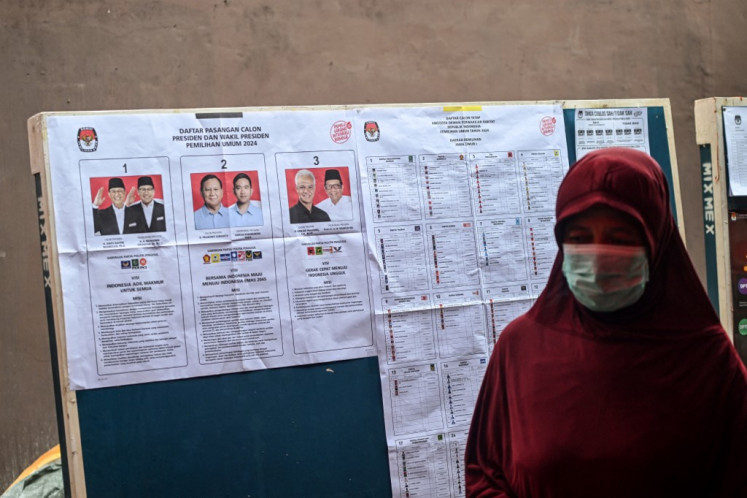Popular Reads
Top Results
Can't find what you're looking for?
View all search resultsPopular Reads
Top Results
Can't find what you're looking for?
View all search resultsAnalysis: Challenges for Indonesian banking industry in 2016
Toward the end of 2015, there were some signs of an improving performance in the Indonesian economy in general and the banking industry in particular
Change text size
Gift Premium Articles
to Anyone
Toward the end of 2015, there were some signs of an improving performance in the Indonesian economy in general and the banking industry in particular.
Economic growth improved to 4.73 percent in the third quarter of 2015, from 4.67 percent in the previous quarter. Moreover, loan growth in the banking industry improved for two straight months. According to the latest data on Indonesian banking statistics, published by the Financial Services Authority (OJK) banking loans in September grew 11.1 percent year-on-year (yoy), compared to 9.7 percent in July and 10.95 percent in August. All kinds of loans were growing slightly faster. Working capital loans (47.8 percent of total loans) grew 10.7 percent yoy, compared to 10.5 percent in the previous month. At the same time, investments and consumer loans grew respectively by 13 percent and 10.1 percent, higher than the previous month of 12.9 percent and 10 percent respectively. Sectors that make the greatest contributions to total loans also grew in September. Loans to the wholesale and retail trade sectors (contributing 19.6 percent of total loans) grew by 10.9 percent yoy in September from 9.9 percent in August, and loans to the processing industry (contributing 18.8 percent of total loans) grew 18.1 percent yoy from 17.9 percent in August.
However, the improving growth in banking loans in September was basically due to the depreciation of the rupiah. The rupiah depreciated by 21.1 percent yoy in September. Rupiah loans (83 percent of total loans) in September grew 10.6 percent yoy, higher than the 9.9 percent in August. Meanwhile, the loans denominated in the rupiah grew 13.8 percent yoy. But after we adjust for the currency depreciation, foreign exchange loans actually contracted by 6 percent yoy. Total loans, adjusted for the depreciation only grew by 7.8 percent, lower than the previous month's 8.1 percent.
The earnings performance of the banking industry remained weak because of the lingering economic downturn. Banks are still building up loan-loss provisions, preparing for rising bad loans in the next few quarters. Average net income growth of the 10 largest Indonesian banks in the period of January to September contracted by 3.9 year yoy. At the same time, provisions for loan losses soared by an average of 85.3 percent. The industry's non-performing loans (NPL) to total loans ratio in September decreased to 2.71 percent from 2.76 percent in August. But the NPL ratio was still higher compared to the second quarter this year at 2.56 percent. There are still some sectors that need more attention because of the high proportion of total credit and high level of NPLs. Loans to the wholesale and retail trade sector still have a trend of increasing NPLs. The NPL ratio in this sector almost doubled from 2.47 percent in 2013 to 4.12 percent in September. There is still a risk of deteriorating credit quality in the future because of the weak economic environment.
Bank Indonesia (BI) has already loosened some of its macro prudential policies to address the weakening economy. The central bank cut the rupiah primary reserve requirement to 7.5 percent from 8 percent starting in December. The primary reserve requirement is the minimum customer deposits commercial banks must hold as reserves in the form of deposits made with the central bank. With lower primary reserve requirements banks will have additional liquidity to lend to the business sector. In our calculations, the banks will have approximately an additional Rp 18.2 trillion (US$1.3 billion), out of a total Rp 3.64 quadrillion in third-party funds. With more liquidity available in the banking sector, the cost of loanable funds will also decrease. According to BI, the primary reserves requirement cut will increase banking loan growth by around 0.6 percent to 1 percent next year. BI expects banking loans will grow between 12 percent and 14 percent next year. But the credit disbursement depends not only on banking liquidity, but also the demand for credit. If the credit growth slowdown in 2014 resulted from tight liquidity, the credit slowdown in 2015 was caused by the low demand for credit and deteriorating credit quality in the banking sector.
Currently, the banking industry will focus more on the improvement of credit quality instead of boosting credit growth and increasing profitability. Higher NPLs mean higher loss provision and lower profitability. The banks that will perform better, with more stable long term performances will be those that are able to maintain their asset quality and liquidity, sustain margins and also increase fee-based income. Even though the Indonesian banking sector is still relatively strong according to international rating agency Moody Investors Service, historically, there are a few banks in a very bad condition in every crisis. Bank asset quality not only affects the financial and operating performance of the bank itself, but also further impinges on the soundness of the national financial system. The deterioration of asset quality from the ignorance of loan quality by banks is one of the main causes behind the financial crisis in Asia (1997-1998) and the US (2008-2009).
The situation next year will still be quite challenging. There is still a risk of a global economic slowdown and the currency volatility will affect many businesses in Indonesia. Banks should remain cautious in their credit disbursement. There are still many industries on 'alert' mode, especially those related to commodities and industries that have high input costs in foreign currencies. But we are still optimistic that economic conditions will improve slightly next year as domestic demand picks up and infrastructure development is executed more quickly. We forecast next year's economic growth will increase to 5 percent, rather than this year's growth forecast of 4.8 percent. Thus we expect that there will also be an improvement in credit growth from around 11 percent yoy this year to between 12 percent and 14 percent yoy next year. But still, the most important thing for banks now is to improve credit quality to maintain the stability of the whole financial sector in Indonesia.
_________________________________
The writer is a financial market analyst at Bank Mandiri










